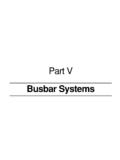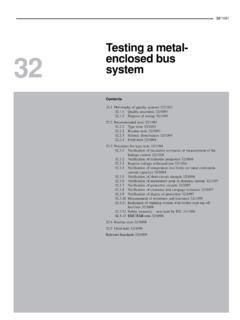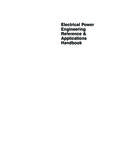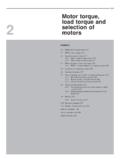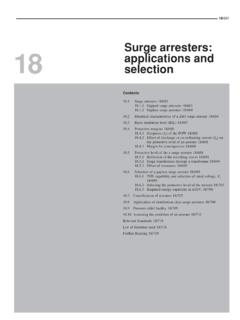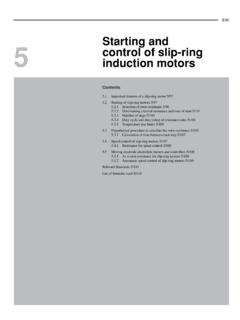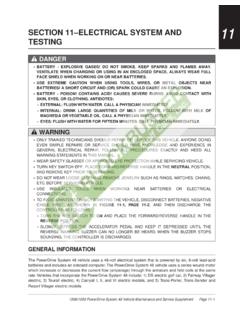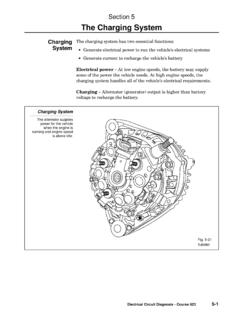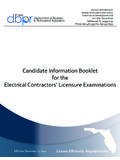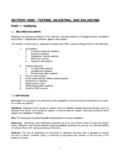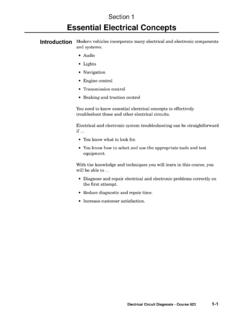Transcription of applications and - Electrical Engineering Book
1 Introduction 15 Types of transformers 15 Voltage transformers (VTs) 15 Current transformers (CTs) 15 Common features of a voltage and a current transformer 15 Design parameters 15/531 Section I: Voltage transformers 15 General specifications and design considerations for voltagetransformers (VTs) 15 Instrument voltage transformers 15 Electromagnetic voltage transformers 15 Residual voltage transformers (RVTs) 15 Capacitor voltage transformers (CVTs) 15 Control transformers 15 Summary of specifications of a VT 15 Precautions to be observed while installing a voltagetransformer 15/543 Section II: Current transformers 15 Current transformers (CTs) 15 General specifications and design considerations forcurrent transformers 15 Measuring current transformers 15 Interposing current transformers 15 Summation current transformers 15 Protection current transformers 15 Special-purpose current transformers, type PS 15 Core-balanced current transformers (CBCTs) 15 Short-time rating and effect of momentary peak or dynamiccurrents 15 Summary of specifications of a CT 15 Precautions to be observed when connecting a CT 15/564 Section III:Testing of instrument and control transformers 15 Test requirements 15 Voltage transformers 15 Current transformers 15/56815 Instrument andcontroltransformers: applications andselection15/529 Section IV.
2 Non-conventional methods of currentmeasurement 15 Sensors 15 shunts 15 Hall effect current sensors 15 Faraday effect optical sensors 15 Zero flux current sensors 15 coil current transducers 15 optical instrument transformers 15/573 Relevant Standards 15/574 List of formulae used 15/574 Further Reading 15/575 Instrument and control transformers: applications and selection15 IntroductionTransformers are used in an auxiliary circuit, linked to apower circuit, to indicate, measure and control its voltagesand currents. They find application in a switchgear or acontrolgear assembly and a switchyard. It would beimpracticable to produce indicating and measuringinstruments or protective devices to operate at high tovery high voltages or currents. The universal practice,therefore, is to transform the high voltages, say, 415 Vand above, and currents above 50 A to reasonably lowvalues, as discussed later, for these applications .
3 Indicatingand measuring instruments and protective devices aredesigned for these reduced values. The transformers usedto transform voltages are known as voltage transformers*and those to transform currents as current we discuss their classifications, basic requirementsand design Types of Voltage transformers (VTs)These may be classified as follows:1 Instrument voltage transformers(i)Conventional two-winding, electromagneticvoltage transformers(ii) Residual voltage transformers (RVTs) and(iii) Capacitor voltage transformers (CVTs). Thesemay be used for metering or protection, withvery little difference between the two as Current transformers (CTs)These may be classified as:1 Instrument current transformers(i) Measuring current transformers(ii) Protection current transformers and(iii) Special-purpose current transformers, class PS.
4 2 Interposing current transformers3 Summation current transformers4 Core balance current transformers (CBCTs) Common features of a voltageand a current Design parameters (service conditionsand likely deratings)These are similar to parameters for a switchgear assemblyas discussed in Section Since they are directlyassociated with the same power system and interruptingdevices as a switchgear assembly, they should generallymeet the requirements for a switchgear assembly, exceptfor small variations in the test requirements. For moredetails refer to the following publications:1 For voltage transformersIEC 60044-2 (for two-winding transformers such asCVTs)2 For current transformersIEC 60044-1 and IEC 60044-6 SECTION I: General specifications anddesign considerations forvoltage transformers (VTs)These transformers develop a voltage on the secondary,substantially proportional to the voltage on the primary(there being no knee point saturation, as is sometimesrequired in CTs (Section (viii)).)
5 Instrument voltage transformers1 Rated primary voltageThis will generally be the nominal system voltage, exceptfor transformers connected between a phase and the groundor between the neutral and the ground, when the primaryvoltage will be considered as 1/ 3 times the nominalsystems voltage (Vr).2 Rated secondary voltageIn Europe and Asian nations this is generally 110 or 110/3 V, ( V) for phase-to-phase or phase-to-groundauxiliary circuits respectively. In the USA and Canadathese voltages are 120 or 120/3 V for distributionsystems and 115 or 115/3 V for transmission Rated frequencyThis may be 50 or 60 Hz as the system may require. Thepermissible variation may be considered as 2% formeasuring as well as protection VTs. These limits arebased on the recommended variations applicable for aswitchgear assembly (IEC 60439-1) or an electric motor(Section ).
6 4 Insulation systemsThese transformers may be PVC taped, thermoplastic(polypropylene) moulded, fibreglass taped, polyester resincast or epoxy resin cast depending upon the system voltageand the surroundings. HV indoor transformers, for instance,are generally polyester or epoxy resin cast, and areeconomical with good dielectric properties. They are resistantto humid, chemically contaminated and hazardous HV transformers, however, may be epoxy resincast, oil or SF6 insulated and oil or SF6 cooled. Epoxyinsulation provides better mechanical and constructionalqualities. They are resistant to humid, contaminated andcorrosive atmospheres and are suitable for all HV* Potential transformer (PT) is not the appropriate word to identifyan instrument voltage Electrical Power Engineering Reference & applications Handbooksystems.
7 They are mechanically strong and can bearshocks and Creepage distancesFor outdoor installations the recommended minimumcreep distances for all types of voltage or currenttransformers are given in Table , according to IEC60044-1 or IEC TappingsTappings are generally not necessary, as a transformer isdesigned for a particular voltage system. If and whensuch a need arises (as in a control transformer ( )) they can be provided on the primary side of Rated outputThe standard ratings, at lagging, may be 10, 15,25, 30, 50, 75, 100, 150, 200, 300, 400 or 500 VA or asthe auxiliary circuit may demand. The procedure todetermine the total VA burden of a circuit is described inSection Typical values of VA burden for a fewinstruments are given in Table from data providedby the Rated burdenThis is the maximum burden the transformer may haveto feed at a time.
8 The preferred values will follow seriesR-10 of ISO-3 (IEC 60059) and as noted in (4).9 Short-time ratingThis is not material in voltage transformers, as neitherthe voltage measuring instruments nor the protective relayswill carry any inrush current during a switching operationor a fault. No short-time rating is thus assigned to electromagnetic unit, however, as used in a residualVT (Section ) or a capacitor VT (Section )should be suitable for carrying the heavy discharge orinrush currents during a capacitor discharge or Accuracy classThe accuracy of a VT depends upon its leakage reactanceand the winding resistance. It determines the voltageand the phase errors of a transformer and varies with theVA on the secondary side. With the use of better corematerial (for permeability) (Section ) and better heatdissipation, one can limit the excitation current and reducethe error.
9 A better core lamination can reduce the coresize and improve heat dissipation. Measuring voltage transformersStandardaccuracy class may be one of , , , 1 or recommended class of accuracy will depend uponthe type of metering and generally as noted inTable Protection voltage transformersGenerally, ameasuring voltage transformer may also be used forthe purpose of protection. A protection transformer,however, is assigned an accuracy class of 3 or 6, whichdefines the highest permissible percentage voltage errorat any voltage between 5% of the rated voltage up tothe voltage obtained by multiplying the rated voltageby the rated voltage factor of , or Andwhen the secondary has a burden between 25% and100% of the rated burden at a of lagging. Thisaccuracy class is followed by a letter P such as 3 Pand 6P etc.
10 The voltage and phase displacement errorsshould not exceed the values noted in Table low voltage of 5%, at which the transformer is required tomaintain its accuracy limit, is of great significance. A protectionTable values of minimum creepagedistances for a VT or a CTPollution levelMinimum creepage distance between phaseand ground mm per kV ( )(phase to phase)Light16 Medium20 Heavy25Ve r y Heavy31 Table values of VA burdens of instrumentsInstrumentsMaximum burden(VA)a1 Voltmeter52 Voltage coil of a watt-meter or a powerfactor meter53 Voltage coil of a frequency coil of a kWh or a kVAr voltmeters56 Voltage coils of recording watt-meters andpower factor coil of a synchroscope15aThese VA burdens are for moving iron instruments. For electronicmeters these values would be of the order of to class of accuracy for VTs for differenttypes of metersApplicationClass of accuracy1 Precision testing or as a for the testing of other VTs2 Meters of precision and Industrial industrial meters ( or , recorders and electronicintegrating meters)5 General industrial measurements1 or 3(Indicating instruments and recorders)6 Purposes where the ratio is of less3importanceNoteTo choose a higher class of accuracy than necessary is not and control transformers.
